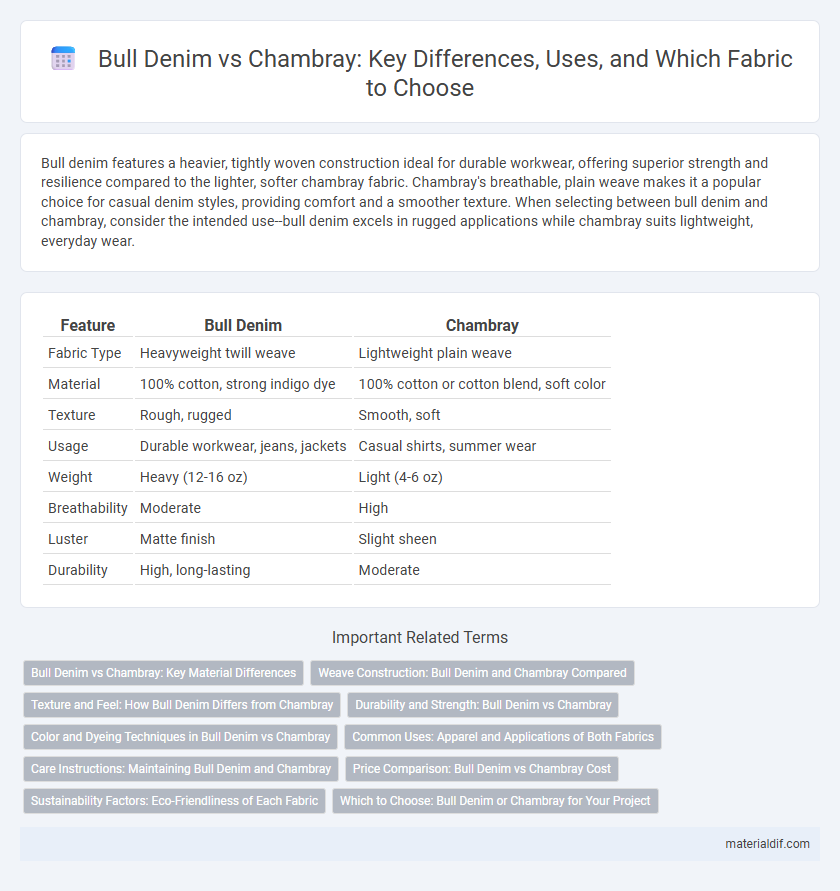Bull denim features a heavier, tightly woven construction ideal for durable workwear, offering superior strength and resilience compared to the lighter, softer chambray fabric. Chambray's breathable, plain weave makes it a popular choice for casual denim styles, providing comfort and a smoother texture. When selecting between bull denim and chambray, consider the intended use--bull denim excels in rugged applications while chambray suits lightweight, everyday wear.
Table of Comparison
| Feature | Bull Denim | Chambray |
|---|---|---|
| Fabric Type | Heavyweight twill weave | Lightweight plain weave |
| Material | 100% cotton, strong indigo dye | 100% cotton or cotton blend, soft color |
| Texture | Rough, rugged | Smooth, soft |
| Usage | Durable workwear, jeans, jackets | Casual shirts, summer wear |
| Weight | Heavy (12-16 oz) | Light (4-6 oz) |
| Breathability | Moderate | High |
| Luster | Matte finish | Slight sheen |
| Durability | High, long-lasting | Moderate |
Bull Denim vs Chambray: Key Material Differences
Bull denim features a heavyweight, rugged cotton weave designed for durability and heavy-duty wear, whereas chambray is a lightweight plain weave fabric typically made with colored warp and white weft threads, offering a softer texture. Bull denim's dense twill construction provides greater resistance to wear and tear, making it ideal for workwear, while chambray's breathing qualities and lighter weight suit casual shirts and summer apparel. The contrasting weave patterns and fabric weights define the distinctive durability and comfort levels between bull denim and chambray materials.
Weave Construction: Bull Denim and Chambray Compared
Bull denim features a heavyweight twill weave construction, characterized by diagonal ribbing that provides durability and a textured finish, ideal for rugged wear. Chambray uses a plain weave with one colored warp and one white weft thread, resulting in a lighter, smoother fabric with a subtle chambray blue appearance. The distinct weave structures lead to Bull denim's sturdiness and thickness, whereas Chambray offers breathability and softness suitable for shirts and lighter clothing.
Texture and Feel: How Bull Denim Differs from Chambray
Bull denim features a heavier, more rigid texture compared to the lightweight, soft feel of chambray, making it ideal for durable workwear. The tightly woven cotton fibers in bull denim create a coarse surface with enhanced roughness and stiffness, while chambray offers a smooth, breathable fabric with a fine weave. This contrast in texture and feel highlights bull denim's robustness against chambray's casual comfort and flexibility.
Durability and Strength: Bull Denim vs Chambray
Bull denim is significantly more durable and stronger than chambray due to its heavier weight and tighter weave, making it ideal for heavy-duty workwear and rugged use. Chambray fabric is lighter, softer, and less resistant to wear and tear, better suited for casual apparel with moderate durability. The robust twill weave of bull denim enhances its tensile strength, whereas chambray's plain weave provides less structural integrity under stress.
Color and Dyeing Techniques in Bull Denim vs Chambray
Bull denim typically features a deep indigo color achieved through multiple dips in natural or synthetic indigo dye, offering a rich, uneven patina with wear. Chambray, in contrast, usually displays a lighter, uniform blue shade created by weaving white cotton threads with dyed blue threads, using reactive or ring dyes for a softer hue. The distinct dyeing techniques in bull denim create a rugged, textured appearance, whereas chambray's color results in a smoother, more consistent fabric surface.
Common Uses: Apparel and Applications of Both Fabrics
Bull denim, known for its heavyweight durability, is commonly used in rugged apparel such as workwear, jeans, and jackets designed for heavy-duty use and outdoor activities. Chambray, lighter and softer with a plain weave, is favored for casual shirts, summer dresses, and lightweight accessories, providing breathability and comfort in warm weather. Both fabrics find applications in fashion, but bull denim suits robust, long-lasting garments while chambray caters to stylish, breathable everyday wear.
Care Instructions: Maintaining Bull Denim and Chambray
Maintaining Bull denim requires cold water washing to prevent color fading and fabric shrinkage, along with air drying to preserve texture and durability. Chambray fabrics benefit from gentle machine washing in warm water and low heat drying to retain softness and prevent fraying. Both materials should avoid bleach and be ironed inside out to maintain their distinctive appearance and longevity.
Price Comparison: Bull Denim vs Chambray Cost
Bull denim typically commands a higher price compared to chambray due to its heavier weight, durability, and premium raw materials. Chambray is more affordable, favored for lightweight, breathable qualities suitable for casual wear and warm climates. The cost difference reflects the production complexity and fabric characteristics, with bull denim often used for rugged, long-lasting garments while chambray serves as a budget-friendly alternative.
Sustainability Factors: Eco-Friendliness of Each Fabric
Bull denim, made from 100% organic cotton fibers, uses less water and fewer chemicals in production, making it more sustainable than conventional denim. Chambray, often woven with blends of cotton and synthetic fibers, has a lighter water footprint but may involve chemicals in the dyeing process that impact eco-friendliness. Both fabrics can benefit from sustainable dyeing and finishing techniques, but bull denim typically ranks higher in overall environmental impact due to its natural composition and production methods.
Which to Choose: Bull Denim or Chambray for Your Project
Bull denim offers a heavier weight and greater durability, making it ideal for rugged workwear or projects requiring long-lasting fabric strength. Chambray provides a lighter, softer texture with a smooth weave, perfect for breathable, casual garments and summer apparel. Choose Bull denim for toughness and longevity, while Chambray suits comfort and versatility in warmer conditions.
Bull denim vs Chambray Infographic

 materialdif.com
materialdif.com